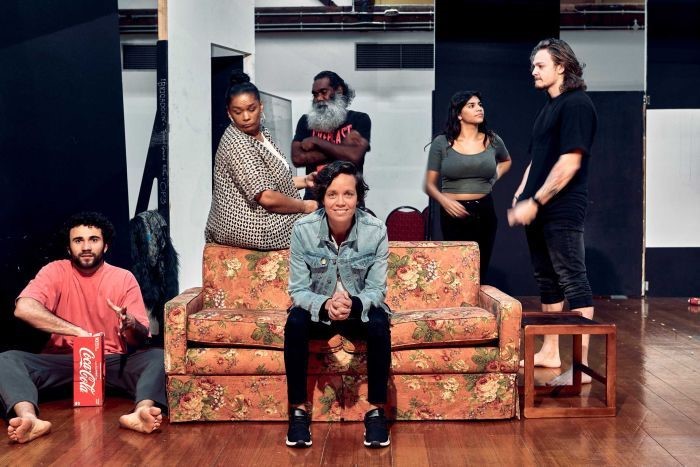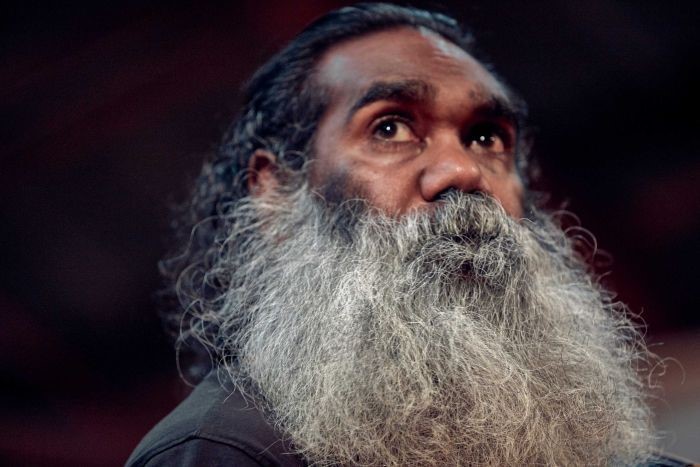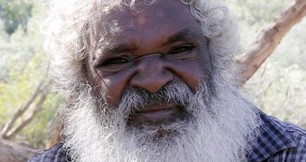Suicide
Brothers Wreck: Fighting back against suicide in Indigenous communities
Matthew Smith – ABC NEWS 27 Jun 2018

Acclaimed actor and playwright Jada Alberts has had enough of the scourge of suicide impacting Indigenous Australians, and she’s using her words to address the issue.
Her play ‘Brothers Wreck’ is about to debut in Adelaide after a season at the Malthouse Theatre in Melbourne.
She told the ABC she was inspired to write the show after her own experience of the issue.
“I think people are touched by suicide no matter what colour you are,” she said.
“I think it’s an epidemic that crosses all boundaries, [but] I don’t think that Australians realise how bad it is in Indigenous communities.”
The 31-year-old said Indigenous suicide rates in some parts of Australia were the highest in the world and up to twenty times the national average.
“I think in general Australia has a difficulty with seeing Indigenous disadvantage and the gap that is between black and white Australia,” she said.
“I think white Australia still has a difficulty with seeing that there is a correlation between those statistics and our history and that we all need to do something about it, rather than it being, this is their problem and so they can clean it up themselves.”
Alberts said she believed not enough had been done to improve the lives of Indigenous Australians.
“We treat people differently based on the colour of their skin and it’s a deep, deep-seated prejudice that has been ingrained into our society,” she said.
“It needs to go because it is discrimination and it is within our institutions and it’s in our schools and it’s everywhere and if we don’t address it, then we will continue to see this huge gap between black and white Australia.”
Using personal experience on stage
Alberts lost a close friend from her church to suicide when she was aged just 15 and witnessed the local community actively sweep the death under the carpet.
That’s a dangerous tendency she wanted to challenge by writing the play, which looks at what’s left for those still living and dealing with the tragedy.
“Young people can only take so much, depending on their support groups and the networks that they have and if you look back at the statistics in the seventies, this was not there, there was very little suicide and in fact I think there was none,” she said.
“But now that this is an option in the world and we see people from all different backgrounds taking their lives and feeling this depression or isolation or hopelessness.”
The winner of the Balnaves Foundation Indigenous Playwright’s Award said cast members of Brothers Wreck had been touched by tragedy caused by the loss of loved ones to suicide.
43-year-old actor Trevor Jamieson was shocked to lose a family member after being recruited to perform in the production.
“During our first rehearsals for the show, the first week actually, I lost a cousin through suicide and that’s sort of become quite real, when I was reading my script and portraying stuff for Jada, her story on stage,” he said.
As a veteran actor, he said the play’s messages — which also include those of humour and hope —are making an impression on audiences.
“We had a standing ovation, tears falling from peoples faces and you’ve got young performers who are amazing,” he said.
We should weep, but more importantly we should act to stop Indigenous suicides
Gerry Georgatos – The Guardian – 10 Sep 2017
I have sat with hundreds of families in Aboriginal and Torres Strait Islander communities that have lost loved ones to suicide. They are crying out to be heard
In the last few years I have written more than 300 articles on the suicide crisis and on suicide prevention. In those same years I have supported hundreds of suicide affected-families and thousands of critically at-risk individuals. In my view, understanding why one has suicidal thoughts should be our most pressing need.
We are losing at least 3,000 Australians to suicide each year. More than one quarter of the national suicide toll is comprised of migrants, particularly of relatively newly arrived migrants from language diverse backgrounds. Refugees who have endured immigration detention are at elevated risk to suicide. The suicide rate of Aboriginal and Torres Strait Islanders is a catastrophic humanitarian crisis. According to the Australian Bureau of Statistics, one in 18 Aboriginal and Torres Strait Islander deaths is a suicide. However, because of under-reporting issues and circumstances where there is an inability to gather adequate evidence to satisfy the coroner of a suicide, I estimate that rather one in 10 Aboriginal and Torres Strait Islander deaths is a suicide.
The nation should weep, but more importantly should act, when 80% of suicides of children aged 12 years and less are of Aboriginal and/or Torres Strait Islander children.
We do not need endless research to identify the elevated risk groups or the ways forward. We know them. We only need to disaggregate. If we don’t, we discriminate; we leave people behind.
The most elevated risk group to life-threatening aberrant behaviour and to suicide are individuals who as children were removed from their biological families, followed by former inmates, the homeless, foster children, the chronically impoverished, newly arrived migrants, culturally and linguistically diverse migrants, and LGBQTI people.
Impoverishment is one of the more significant risk factors that leads to suicidal ideation. Aberrant behaviours and depression are more pronounced among the impoverished. The more education someone has completed, the greater the suite of their protective factors to steering clear from suicidal ideation. The majority of the national prison population has not completed year 12 – in fact the majority have not completed year 9. High levels of education are a more significant protective factor than full-time employment. More education translates to a dawn of new meanings, to a better understanding of the self, to a more positive psychosocial self, to the pursuit of what happiness and its contexts can and should mean.
Identifying trauma in any given population must recognise underlying narratives, and from within these narratives consequently understand the triggers that can lead to serious depression, disordered thinking – to the tipping points.
Aboriginal and Torres Strait Islander suicides are predominately borne of poverty and disparities. I have travelled through hundreds of Aboriginal and Torres Strait Islander communities, and with many of these communities the poverty is third-world-akin. Many of these communities have been degraded from missions and reserves to corrals of human misery and suffering; where hardly anyone completes year 12, where few have any serious employment, where all hope is extinguished.
That this should be their lot is an abomination – moral and political. The degradation of these communities is not the fault of the communities but the fault of our governments.
Very few Aboriginal and Torres Strait Islanders living above the poverty line kill themselves. The improving of life circumstances for impoverished and disadvantaged Aboriginal and Torres Strait Islanders is the only way forward to reducing one of the world’s highest suicide rates. More needs to be done for the impoverished, for those without hope.
The multifactorial issues that lead to Aboriginal and Torres Strait Islander suicides are the same that lead to the abominable arrest, jail and homeless rates of Aboriginal peoples. Today, one in 13 of Western Australia’s Aboriginal adult males are in prison. Prisons are filled with the low-level offending borne of the tsunami of poverty-related issues.
In my time in the tertiary sector, I assisted many former inmates and homeless individuals into education, gaining entry to an educational institution and hence in supporting them from the point of entry to the point exit. None of those souls I assisted landed back in jail or on the streets.
Of the world’s middle and high income nations with recent colonial oppressor histories, Australia has the widest divide in all measurable indicators between its first peoples and the rest of the population.
For all Australians, whether they are descendants of the first peoples, newly arrived migrants from culturally diverse backgrounds, or marginalised Australians, there is an accumulation of stress that we never before had in our nation. There is also an unprecedented capacity of hate today. It plays out in racism, in competition, in general unhappiness and degenerates into hate, anger, mobbing and bullying. The constancy of these traumas can become irrecoverable for some.
We cannot continue to live in silence and dangerously internalise this tragedy. The hundreds of suicide affected families I have sat with, who have lost their loved ones, are crying out to be heard, they are screaming.
Self-destructive behaviours that can culminate in suicidal behaviours are preventable.
I remember the suicide affected families and those lost who continue to echo in the hearts of those they have left behind. I remember children lost to suicide, as young as nine. We need education to lead with the knowledge that at all times we need to be civil, courteous, kind to one another. We have to be there for one another – people need people.
We should tell the stories of those lost. Let us be fearless in this, for in the telling of their stories the imperatives of the ways forward will be reinforced.
I remember a father who found his son hours after his suicide. The father lay his son down and cradled his body through the night till responders arrived in the morning. I remember the distraught family of a young man who only a week before his suicide had run into a burning house and rescued a young mother and her baby. I remember attending the funerals of three young people in the one community – three burials in five days, three graves in a row. The youngest was a 15-year-old girl. I wailed on the inside as I stared at three graves. I remember a father of six children who took his life, a mother of five children who took her life, a pregnant mother who took her life. I remember a 10-year-old child who took her life, an 11-year-old boy who took his life, a 12-year-old girl who took her life.
As a nation we lay claim to responding to the suicide crisis. We are one of only 28 nations with a “suicide prevention plan”. But it’s paper-thin. It’s about encouraging services to work together in suicide prevention and postvention. We are nowhere near it. As a nation we have not prioritised this harrowing crisis.
As a young child I remember the absorption of sadness by some of Sydney’s Greek community of the suicide by a newly-arrived young Greek male. Years later I would read some of his letters to the homeland, yearning to return after he made his quid in a country he believed found it hard to accept him. This is the tale of many newly-arrived migrants albeit to one of the world’s most culturally diverse nations. Racism has many veils and layers and misoxeny and xenophobia are toxic. Today, in my work with suicide affected families and my research, in my many journeys I find that there are more stresses today than yesterday, more unhappiness today than yesterday.
Identifying trauma and understanding the issues that despair individuals and collectively as families are imperative in tailor-making the education, the conversations and the support. We start with behavioural observations and proceed with the opportunity for the individual to tell their story.
What makes for unhappiness and happiness has to be understood – human beings are inherently courageous. People want to choose happiness but a muddle-minded society has been getting in the way. The factors that can culminate in suicide are the most preventable of the various destructive behaviours that impact on families and communities.
Understanding one another, understanding unfairness, helping one another, being there for one another are the most profound steps to suicide prevention. We have to spread the love and do this with a salt-of-the-earth approach. We must lead by example in making sense of the world, in supporting others to improve their life circumstances and to understand happiness.
Suicide rate for young Indigenous men highest in world, Australian report finds
Siobhan Fogarty – ABC NEWS 12 Aug 2016
The rate of suicide among young Indigenous men is the highest in the world, according to a new report highlighting the challenges facing young Australians.
The first ever Australian Youth Development Index (YDI) was compiled as part of International Youth Day.
The index helps formulate youth development policy in the domains of education, health and wellbeing, employment as well as political and civic participation, measured across 16 key indicators.
It rates a state or territory’s performance with a score between zero and one, with one being a perfect score.
Among the report’s findings were alarming statistics on youth suicide, which showed Aboriginal and Torres Strait Islander men between 25 and 29 had the highest suicide rates in the entire world.
“What that says is that we as a country are failing that particular group of young men,” Youth Action chief executive Katie Acheson said.
“When we look at all the countries that are measuring suicide rates it is shocking that Aboriginal males are so stigmatised and that number is so high.
“We have to do something now.”
The index found Tasmania and Queensland recorded an increase in suicide rates despite national rates remaining steady.
Health and wellbeing registered the most significant deterioration over a 10-year period, with the index’s authors attributing that to mental health issues and the increasing use of alcohol and other drugs.
Overall, the Australian Capital Territory had the highest YDI score at 0.851, while the Northern Territory had the lowest score at 0.254.
Research finds youth are struggling to gain employment
The report also found employment opportunities for young people had declined in every state and territory, with the NT recording a drop of 80 per cent since 2006.
It also found that in all states and territories, the percentage of young people not engaged in education, employment or training was significantly higher for rural youth than for those in the cities.
“What was really interesting is that there’s a really huge gap between rural and urban areas, so young people in urban areas are more likely to get a job and have education opportunities,” Ms Acheson said.
“Young people in regional areas have far greater inequality in that their access to education and employment is much worse than those young people in the city.”
However, the report suggested political participation by young Australians had grown.
“The data is saying that in some areas we’re doing pretty well, so political participation in Australia has gone up since 2006,” Ms Acheson said.
“Pretty much everywhere we’ve seen an increase in young people having more of a voice and taking more action.”
Australia’s Youth Development Index ‘very high’ in global terms
The index took information from the Australian Bureau of Statistics, including census data, as well as figures from health and education departments, such as NAPLAN data.
The elders left behind
The report also found that despite a high level of youth development in Australia compared to other nations, there were gaps at a regional level, between city and country and Indigenous and non-Indigenous youth.
It also found that many important youth issues were not measured by data or were measured but those figures were not readily available or comprehensive enough for analysis by indexes such as the YDI.
Nonetheless, in a global context, Australia’s YDI was considered “very high”.
The report also found that Australia had improved in all domains except youth health and wellbeing, where it had gone backwards, against the global trend.
The report said the Northern Territory had the highest proportion of young people in its population out of any state or territory — around one in every three people — but had managed to register the biggest improvement in its performance over the 10-year period, with a 30 per cent increase in its overall YDI score.



